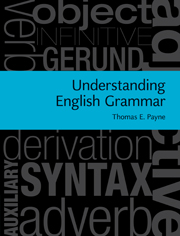Book contents
- Frontmatter
- Contents
- List of figures
- List of tables
- Preface
- Acknowledgements
- List of typographical conventions and abbreviations
- Introduction
- 1 History
- 2 Typology
- 3 The lexicon
- 4 Morphology – the shapes of words
- 5 Participant reference
- 6 Actions, states, and processes
- 7 Basic concepts in English syntax
- 8 Advanced concepts in English syntax
- 9 Complementation
- 10 Modification
- 11 Auxiliaries and the “black hole” of English syntax
- 12 Time and reality
- 13 Voice and valence
- 14 Clause combining
- 15 Pragmatic grounding and pragmatically marked constructions
- Glossary
- Endnotes
- References
- Index
15 - Pragmatic grounding and pragmatically marked constructions
Published online by Cambridge University Press: 05 June 2012
- Frontmatter
- Contents
- List of figures
- List of tables
- Preface
- Acknowledgements
- List of typographical conventions and abbreviations
- Introduction
- 1 History
- 2 Typology
- 3 The lexicon
- 4 Morphology – the shapes of words
- 5 Participant reference
- 6 Actions, states, and processes
- 7 Basic concepts in English syntax
- 8 Advanced concepts in English syntax
- 9 Complementation
- 10 Modification
- 11 Auxiliaries and the “black hole” of English syntax
- 12 Time and reality
- 13 Voice and valence
- 14 Clause combining
- 15 Pragmatic grounding and pragmatically marked constructions
- Glossary
- Endnotes
- References
- Index
Summary
I personally think we developed language because of our deep inner need to complain.
Jane Wagner (1986:133)Pragmatics is the practice of utterance interpretation (Levinsohn 1983). Speakers and hearers are continuously engaged in pragmatic interpretation of contexts and utterances whenever they participate in communication, whether it be conversing with friends, reading a textbook, complaining, or engaging in any other form of communication. Utterances are actual instances of language in use; therefore they always occur in a context and their interpretations always affect and are affected by the context (Sperber and Wilson 1995). While semantics has to do with the propositional meaning of linguistic structures, pragmatics has to do with the use of structures in actual contexts. A well-formed and meaningful utterance may have very different pragmatic interpretations depending on how it is used in different contexts. Take for example, a simple utterance like:
(1) I like vegetables.
In reply to the suggestion “Let's have steak for dinner!” the utterance in (1) may be understood as a negative response. However, following the suggestion “Let's have ratatouille for dinner!” the same utterance will probably be understood as affirmative agreement. The propositional meaning of the utterance is the same in both cases, but the pragmatic effect is quite different, simply because of the context.
- Type
- Chapter
- Information
- Understanding English GrammarA Linguistic Introduction, pp. 358 - 382Publisher: Cambridge University PressPrint publication year: 2010



